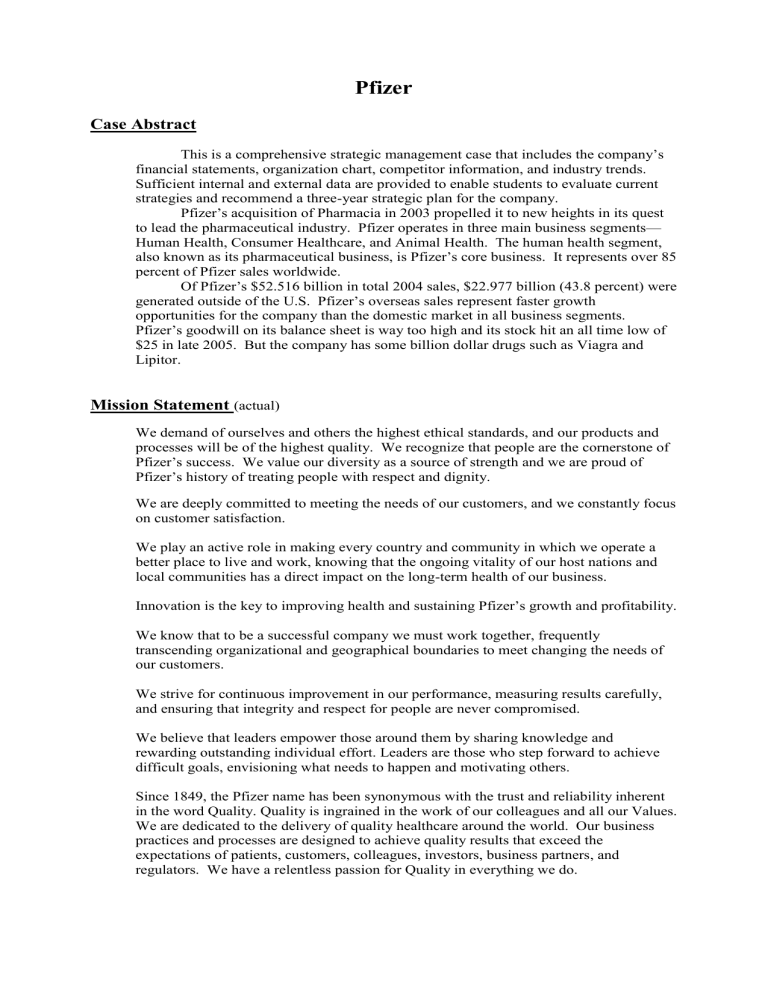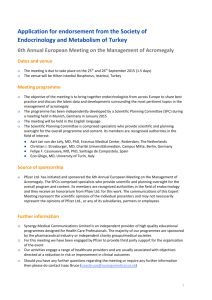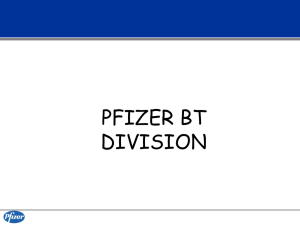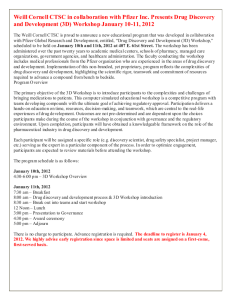
Pfizer Case Abstract This is a comprehensive strategic management case that includes the company’s financial statements, organization chart, competitor information, and industry trends. Sufficient internal and external data are provided to enable students to evaluate current strategies and recommend a three-year strategic plan for the company. Pfizer’s acquisition of Pharmacia in 2003 propelled it to new heights in its quest to lead the pharmaceutical industry. Pfizer operates in three main business segments— Human Health, Consumer Healthcare, and Animal Health. The human health segment, also known as its pharmaceutical business, is Pfizer’s core business. It represents over 85 percent of Pfizer sales worldwide. Of Pfizer’s $52.516 billion in total 2004 sales, $22.977 billion (43.8 percent) were generated outside of the U.S. Pfizer’s overseas sales represent faster growth opportunities for the company than the domestic market in all business segments. Pfizer’s goodwill on its balance sheet is way too high and its stock hit an all time low of $25 in late 2005. But the company has some billion dollar drugs such as Viagra and Lipitor. Mission Statement (actual) We demand of ourselves and others the highest ethical standards, and our products and processes will be of the highest quality. We recognize that people are the cornerstone of Pfizer’s success. We value our diversity as a source of strength and we are proud of Pfizer’s history of treating people with respect and dignity. We are deeply committed to meeting the needs of our customers, and we constantly focus on customer satisfaction. We play an active role in making every country and community in which we operate a better place to live and work, knowing that the ongoing vitality of our host nations and local communities has a direct impact on the long-term health of our business. Innovation is the key to improving health and sustaining Pfizer’s growth and profitability. We know that to be a successful company we must work together, frequently transcending organizational and geographical boundaries to meet changing the needs of our customers. We strive for continuous improvement in our performance, measuring results carefully, and ensuring that integrity and respect for people are never compromised. We believe that leaders empower those around them by sharing knowledge and rewarding outstanding individual effort. Leaders are those who step forward to achieve difficult goals, envisioning what needs to happen and motivating others. Since 1849, the Pfizer name has been synonymous with the trust and reliability inherent in the word Quality. Quality is ingrained in the work of our colleagues and all our Values. We are dedicated to the delivery of quality healthcare around the world. Our business practices and processes are designed to achieve quality results that exceed the expectations of patients, customers, colleagues, investors, business partners, and regulators. We have a relentless passion for Quality in everything we do. External Audit Opportunities 1. Demand for drugs is relatively inelastic. 2. Worldwide pharmaceutical sales continue to grow faster than most segments of the world economy. 3. World pharmaceutical sales to exceed $570 billion in 2005, up 7.5 percent. 4. Advancements in technology. 5. Lengthening of average life expectancy with the population of those 65 and older expanding by about 79 percent from 2002 to 2025. 6. Increased incidence of chronic diseases. 7. Barriers to entry are high. Threats 1. Many major pharmaceutical companies are facing major patent expirations. 2. Food and Drug Administration (FDA) asks drug manufacturers to suspend sales of certain prescription medicines in the US. 3. Adverse effect on drug prices due to threat of imported drugs. 4. Assets located overseas from global markets are subject to threat of expropriation and terrorism. 5. Threats of global business in dealing with varied regulatory environments and currency fluctuations. 6. The FDA is asking makers of NSAIDs to revise labels and include more information. 7. Increased competition from manufacturers of generic drugs in 2004 was 9.7 percent higher. 8. Medicaid requires pharmacists to offer generic brands instead of name-brand drugs if they are equally rated by the government. 9. Some laws and regulations are forcing pharmaceutical companies to give rebates or discounts when products are purchased by certain federal and state programs or agencies. 10. Increased consumption of natural supplements. 11. Increasing pricing pressures. 12. Negative publicity. 13. Increased cost of insurance. Internal Audit Strengths An international network that promotes good corporate citizenship. 1. Total stockholders’ equity more than tripled between 2002 and 2004. 2. Almost 50 percent of sales are generated internationally. 3. Largest human health sector in the world. 4. Consolidation taking place in the health care industry increases purchasing power and shifts bargaining power in their favor. 5. Web site is well designed and useful. 6. Launched its own generic products through its subsidiary, Greenstone Ltd. 7. Lipitor sets new sales records and is the pharmaceutical industry's first $10 billion product. 8. Introduction of first modified-live virus vaccine line in 2005, with the strength to deliver fetal protection for one full year. 9. World’s largest drug company with leading global sales of $50.9 billion. 10. Largest animal health business in the world. 11. Holds 13.1 percent of market share making it the largest pharmaceutical firm. 12. Zoloft is the most prescribed anti-depressant in the U.S. Weaknesses 1. Stock price has been losing value over the past five years and is below the S&P 500 average. 2. Lowest earnings per share ($1.23) among direct competitors. 3. Delays caused by regulations and the unsuccessful completion of clinical trials reduce the potential recovery and returns of investments such as R&D. 4. Not serving African and Australian markets. 5. Unexpected side effects of drugs. 6. Lack of organizational structure. 7. Decreased amount of advertising. CPM – Competitive Profile Matrix Critical Success Factors Organizational Structure Price Competitiveness Advertising Product Quality Sales Distribution Customer Loyalty Market Share Global Expansion Demographics Financial Position Research and Development Innovation Total Weight 0.05 0.10 0.04 0.10 0.10 0.03 0.11 0.11 0.03 0.15 0.13 0.10 1.00 Pfizer Rating Weighted Score 2 0.10 3 0.30 1 0.04 3 0.30 4 0.40 3 0.09 4 0.44 4 0.44 3 0.09 4 0.60 4 0.52 3 0.30 3.52 Rating 4 3 1 3 3 3 3 4 3 3 4 3 Merck Weighted Score 0.20 0.30 0.04 0.30 0.30 0.09 0.33 0.44 0.09 0.45 0.52 0.30 3.16 Bayer Rating Weighted Score 1 0.05 3 0.30 4 0.16 3 0.30 2 0.20 3 0.09 2 0.22 3 0.33 3 0.09 2 0.30 3 0.39 2 0.20 2.58 Financial Ratio Analysis (January 2006) Growth Rates % Sales (Qtr vs year ago qtr) Net Income (YTD vs YTD) Net Income (Qtr vs year ago qtr) Sales (5-Year Annual Avg.) Net Income (5-Year Annual Avg.) Dividends (5-Year Annual Avg.) Price Ratios Current P/E Ratio P/E Ratio 5-Year High P/E Ratio 5-Year Low Price/Sales Ratio Price/Book Value Price/Cash Flow Ratio Profit Margins Gross Margin Pre-Tax Margin Net Profit Margin 5Yr Gross Margin (5-Year Avg.) 5Yr PreTax Margin (5-Year Avg.) 5Yr Net Profit Margin (5-Year Avg.) Financial Condition Debt/Equity Ratio Current Ratio Quick Ratio Interest Coverage Leverage Ratio Book Value/Share Investment Returns % Return On Equity Return On Assets Return On Capital Pfizer (5.00) (37.30) (52.40) 14.86 7.25 15.37 Industry 4.90 (4.40) (9.50) 2.09 2.87 7.96 SP-500 14.20 15.90 15.10 4.78 11.04 4.61 22.4 83.5 14.8 3.46 2.73 13.30 21.8 40.4 16.1 3.39 4.38 15.40 19.0 64.8 17.4 1.53 2.93 12.50 87.6 22.2 15.5 87.0 23.5 18.9 79.0 23.3 16.2 74.7 23.2 17.3 47.3 12.1 8.3 47.3 9.4 5.9 0.08 1.6 1.1 34.6 1.7 9.04 0.22 1.7 1.3 26.6 2.0 9.05 1.07 1.4 0.9 3.5 5.8 13.21 12.3 7.4 11.3 20.9 10.5 17.1 15.9 2.8 7.7 Return On Equity (5-Year Avg.) Return On Assets (5-Year Avg.) Return On Capital (5-Year Avg.) Management Efficiency Income/Employee Revenue/Employee Receivable Turnover Inventory Turnover Asset Turnover Adapted from www.cnbc.com 19.4 10.1 16.2 26.2 12.1 20.6 12.0 2.0 5.7 71,000 458,000 5.3 1.0 0.5 64,000 395,000 5.8 2.0 0.7 30,000 366,000 7.7 7.8 0.4 Date Avg. P/E 12/04 20.50 12/03 147.30 12/02 23.00 12/01 33.10 12/00 67.20 Adapted from www.cnbc.com Price/Sales 3.83 5.97 5.82 7.75 9.83 Date Book Value/ Share 12/04 $9.11 12/03 $8.54 12/02 $3.24 12/01 $2.91 12/00 $2.55 Adapted from www.cnbc.com Debt/Equity 0.11 0.09 0.16 0.14 0.07 Price/Book 2.95 4.14 9.44 13.69 18.04 ROE (%) 16.7 6.0 47.8 42.6 23.2 Net Profit Margin (%) 21.6 3.6 28.4 24.0 12.6 ROA (%) 9.2 3.4 20.6 19.9 11.1 Interest Coverage 41.3 13.1 48.0 39.8 15.9 Net Worth Analysis (January 2006 in millions) 1. Stockholders’ Equity + Goodwill = 68,278 + 23,756 2. Net income x 5 = $11,361 x 5= 3. Share price = $25.00/EPS 1.10 =$22.73 x Net Income $11,361= 4. Number of Shares Outstanding x Share Price = 7,371 x $25.00 = Method Average $ 92,034 $ 56,805 $ 25,820 $ 184,275 $89,733 EPS/EBIT Analysis $ Amount Needed: 27,000M Stock Price: $25 Tax Rate: 19% Interest Rate: 7% # Shares Outstanding: 7,371M EBIT Common Stock Financing Recession Normal Boom Recession $5,000,000,000 $10,000,000,000 $15,000,000,000 $5,000,000,000 70 Percent Stock - 30 Percent Debt Recession $5,000,000,000 Normal $10,000,000,000 Debt Financing Normal Boom $10,000,000,000 $15,000,000,000 70 Percent Debt - 30 Percent Stock Boom Recession $15,000,000,000 $5,000,000,000 Normal $10,000,000,000 MAKE YOUR OWN ASSUMPTIONS AS TO ITS WEIGHT AND RATING. DO THE FOLLOWING: a. External Factor Evaluation Matrix b. Internal Factor Evaluation Matrix c. SWOT Matrix d. SPACE Matrix e. Grand Strategy Matrix f. Internal-External Matrix g. QSPM Boom $15,000,000,000



![-----Original Message----- From: Yates, William O. [ ]](http://s2.studylib.net/store/data/015588454_1-7c4ca8680529e74e412b8e161d2dab08-300x300.png)